Lean Construction Practices and BIM Integration
VerifiedAdded on 2020/12/04
|17
|4429
|68
Project
AI Summary
This assignment delves into the application of lean construction principles within the context of building information modeling (BIM). It examines how these two methodologies can be combined to enhance project management efficiency, highlighting best practices and their impact on various stages of a construction project. The analysis includes a stakeholder engagement strategy, project phase breakdown, and an exploration of the benefits derived from integrating lean construction and BIM.
Contribute Materials
Your contribution can guide someone’s learning journey. Share your
documents today.
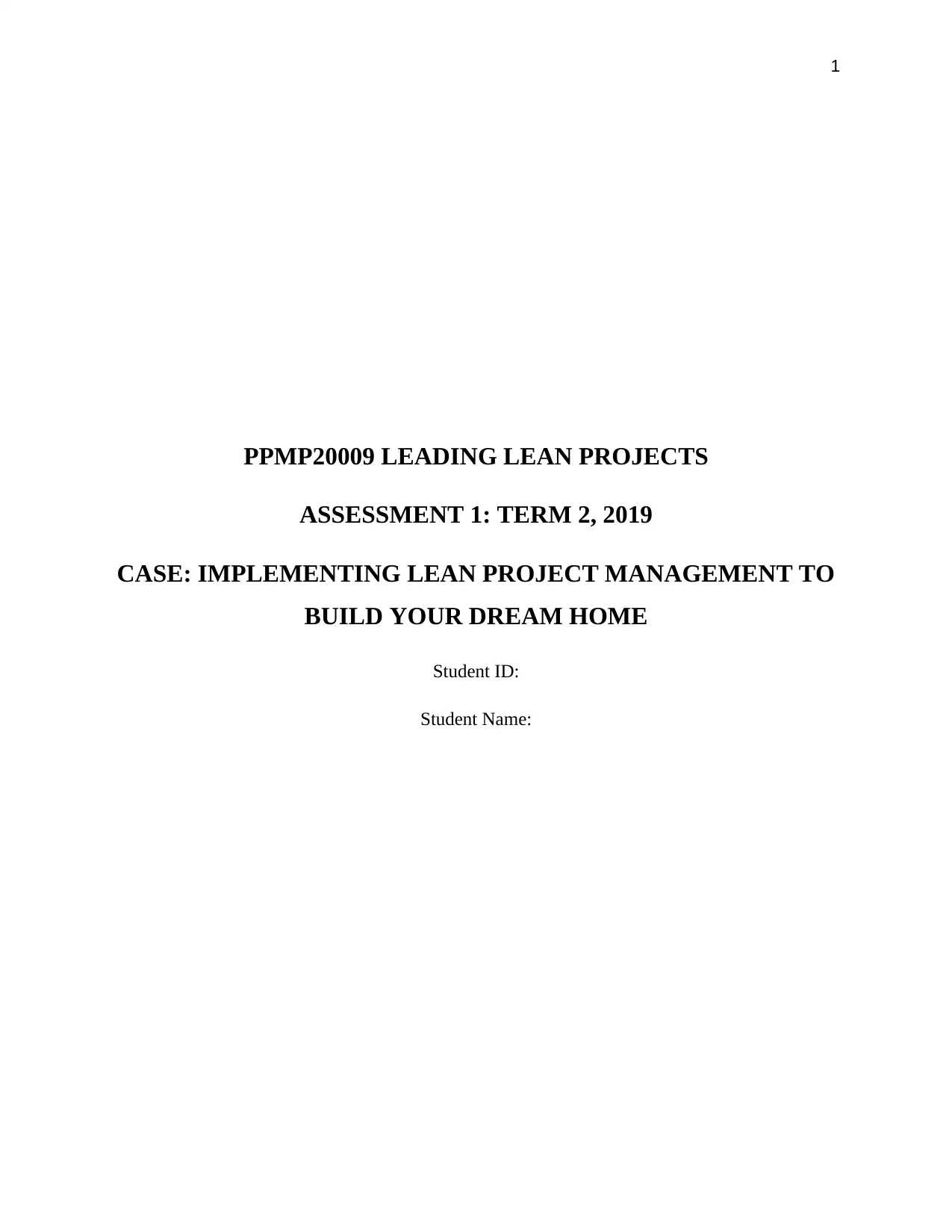
1
PPMP20009 LEADING LEAN PROJECTS
ASSESSMENT 1: TERM 2, 2019
CASE: IMPLEMENTING LEAN PROJECT MANAGEMENT TO
BUILD YOUR DREAM HOME
Student ID:
Student Name:
PPMP20009 LEADING LEAN PROJECTS
ASSESSMENT 1: TERM 2, 2019
CASE: IMPLEMENTING LEAN PROJECT MANAGEMENT TO
BUILD YOUR DREAM HOME
Student ID:
Student Name:
Secure Best Marks with AI Grader
Need help grading? Try our AI Grader for instant feedback on your assignments.
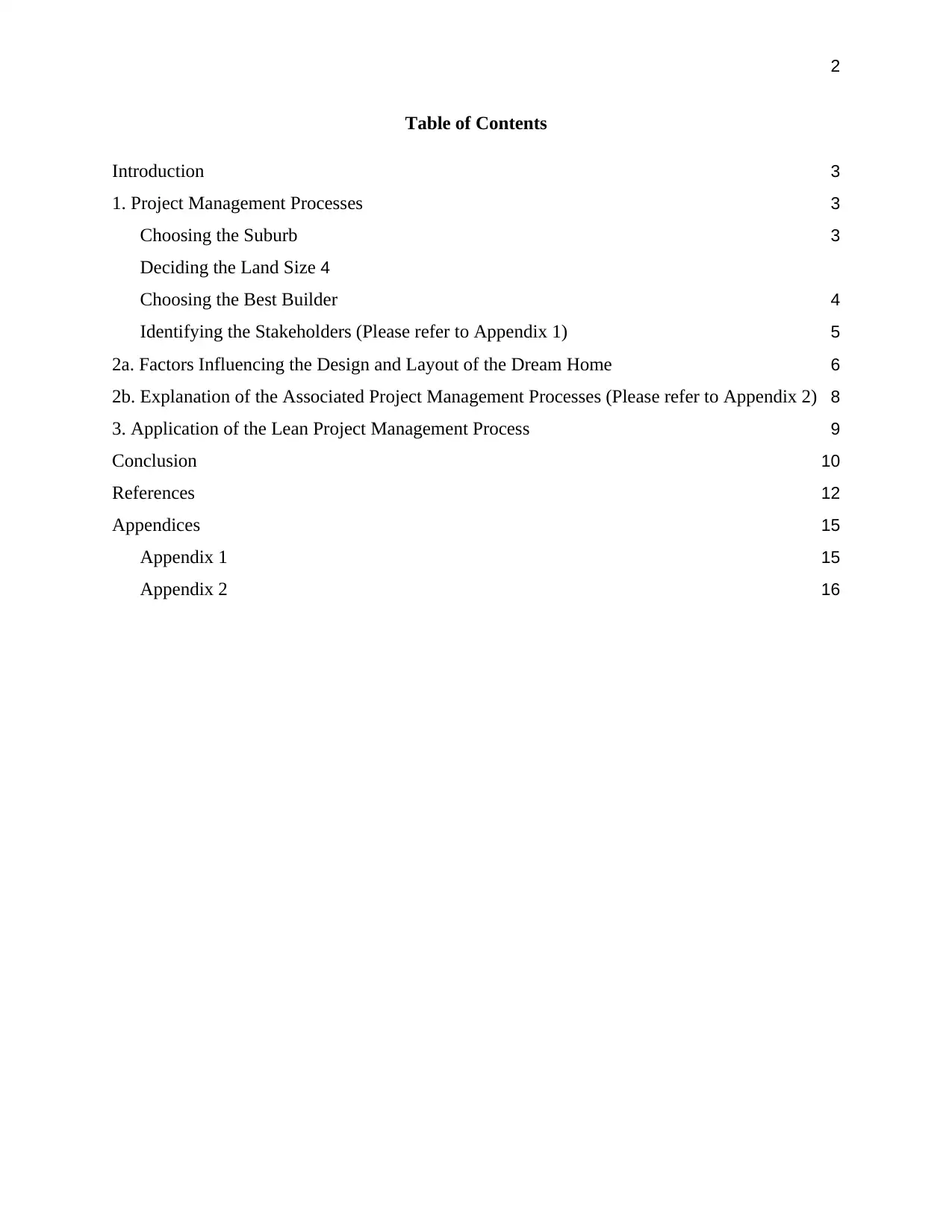
2
Table of Contents
Introduction 3
1. Project Management Processes 3
Choosing the Suburb 3
Deciding the Land Size 4
Choosing the Best Builder 4
Identifying the Stakeholders (Please refer to Appendix 1) 5
2a. Factors Influencing the Design and Layout of the Dream Home 6
2b. Explanation of the Associated Project Management Processes (Please refer to Appendix 2) 8
3. Application of the Lean Project Management Process 9
Conclusion 10
References 12
Appendices 15
Appendix 1 15
Appendix 2 16
Table of Contents
Introduction 3
1. Project Management Processes 3
Choosing the Suburb 3
Deciding the Land Size 4
Choosing the Best Builder 4
Identifying the Stakeholders (Please refer to Appendix 1) 5
2a. Factors Influencing the Design and Layout of the Dream Home 6
2b. Explanation of the Associated Project Management Processes (Please refer to Appendix 2) 8
3. Application of the Lean Project Management Process 9
Conclusion 10
References 12
Appendices 15
Appendix 1 15
Appendix 2 16
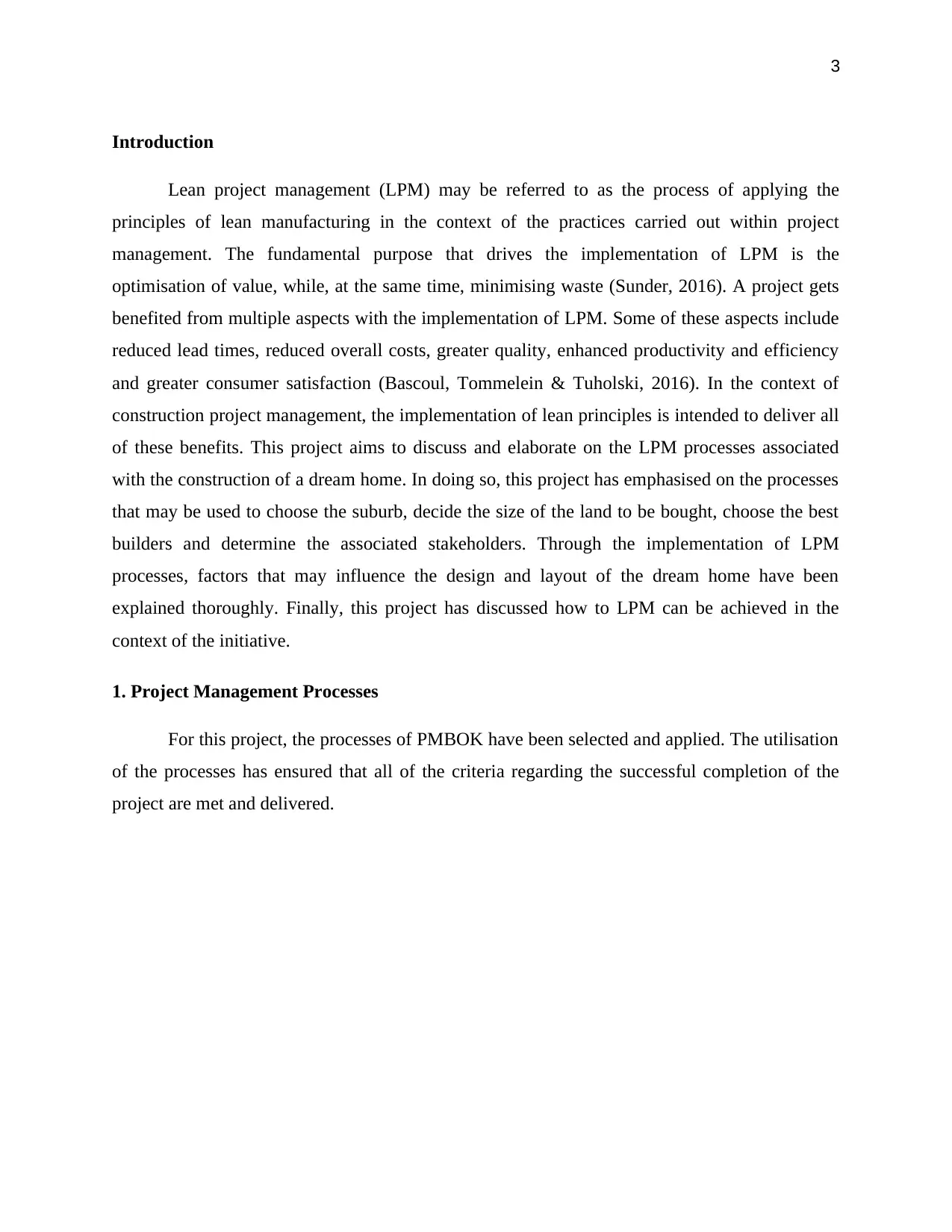
3
Introduction
Lean project management (LPM) may be referred to as the process of applying the
principles of lean manufacturing in the context of the practices carried out within project
management. The fundamental purpose that drives the implementation of LPM is the
optimisation of value, while, at the same time, minimising waste (Sunder, 2016). A project gets
benefited from multiple aspects with the implementation of LPM. Some of these aspects include
reduced lead times, reduced overall costs, greater quality, enhanced productivity and efficiency
and greater consumer satisfaction (Bascoul, Tommelein & Tuholski, 2016). In the context of
construction project management, the implementation of lean principles is intended to deliver all
of these benefits. This project aims to discuss and elaborate on the LPM processes associated
with the construction of a dream home. In doing so, this project has emphasised on the processes
that may be used to choose the suburb, decide the size of the land to be bought, choose the best
builders and determine the associated stakeholders. Through the implementation of LPM
processes, factors that may influence the design and layout of the dream home have been
explained thoroughly. Finally, this project has discussed how to LPM can be achieved in the
context of the initiative.
1. Project Management Processes
For this project, the processes of PMBOK have been selected and applied. The utilisation
of the processes has ensured that all of the criteria regarding the successful completion of the
project are met and delivered.
Introduction
Lean project management (LPM) may be referred to as the process of applying the
principles of lean manufacturing in the context of the practices carried out within project
management. The fundamental purpose that drives the implementation of LPM is the
optimisation of value, while, at the same time, minimising waste (Sunder, 2016). A project gets
benefited from multiple aspects with the implementation of LPM. Some of these aspects include
reduced lead times, reduced overall costs, greater quality, enhanced productivity and efficiency
and greater consumer satisfaction (Bascoul, Tommelein & Tuholski, 2016). In the context of
construction project management, the implementation of lean principles is intended to deliver all
of these benefits. This project aims to discuss and elaborate on the LPM processes associated
with the construction of a dream home. In doing so, this project has emphasised on the processes
that may be used to choose the suburb, decide the size of the land to be bought, choose the best
builders and determine the associated stakeholders. Through the implementation of LPM
processes, factors that may influence the design and layout of the dream home have been
explained thoroughly. Finally, this project has discussed how to LPM can be achieved in the
context of the initiative.
1. Project Management Processes
For this project, the processes of PMBOK have been selected and applied. The utilisation
of the processes has ensured that all of the criteria regarding the successful completion of the
project are met and delivered.
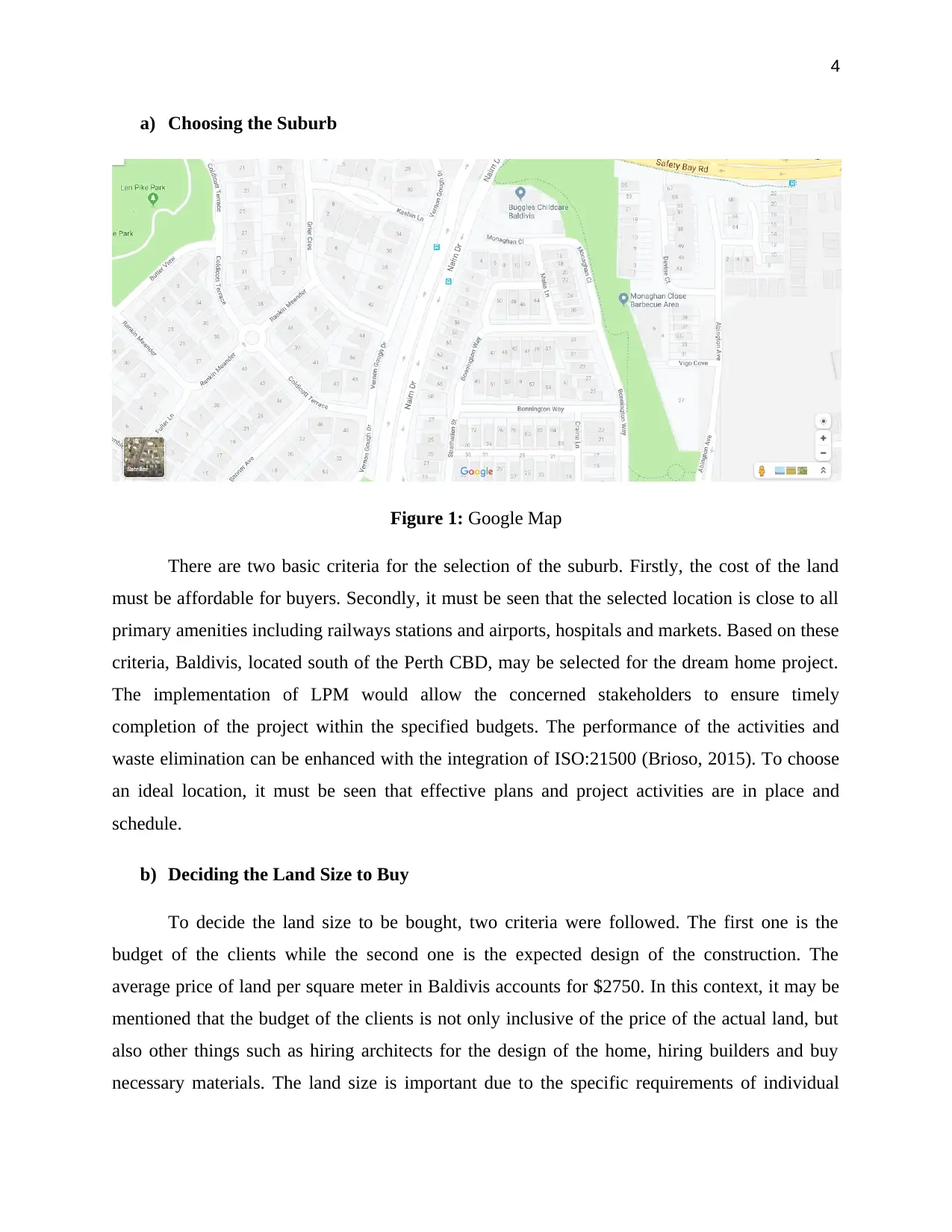
4
a) Choosing the Suburb
Figure 1: Google Map
There are two basic criteria for the selection of the suburb. Firstly, the cost of the land
must be affordable for buyers. Secondly, it must be seen that the selected location is close to all
primary amenities including railways stations and airports, hospitals and markets. Based on these
criteria, Baldivis, located south of the Perth CBD, may be selected for the dream home project.
The implementation of LPM would allow the concerned stakeholders to ensure timely
completion of the project within the specified budgets. The performance of the activities and
waste elimination can be enhanced with the integration of ISO:21500 (Brioso, 2015). To choose
an ideal location, it must be seen that effective plans and project activities are in place and
schedule.
b) Deciding the Land Size to Buy
To decide the land size to be bought, two criteria were followed. The first one is the
budget of the clients while the second one is the expected design of the construction. The
average price of land per square meter in Baldivis accounts for $2750. In this context, it may be
mentioned that the budget of the clients is not only inclusive of the price of the actual land, but
also other things such as hiring architects for the design of the home, hiring builders and buy
necessary materials. The land size is important due to the specific requirements of individual
a) Choosing the Suburb
Figure 1: Google Map
There are two basic criteria for the selection of the suburb. Firstly, the cost of the land
must be affordable for buyers. Secondly, it must be seen that the selected location is close to all
primary amenities including railways stations and airports, hospitals and markets. Based on these
criteria, Baldivis, located south of the Perth CBD, may be selected for the dream home project.
The implementation of LPM would allow the concerned stakeholders to ensure timely
completion of the project within the specified budgets. The performance of the activities and
waste elimination can be enhanced with the integration of ISO:21500 (Brioso, 2015). To choose
an ideal location, it must be seen that effective plans and project activities are in place and
schedule.
b) Deciding the Land Size to Buy
To decide the land size to be bought, two criteria were followed. The first one is the
budget of the clients while the second one is the expected design of the construction. The
average price of land per square meter in Baldivis accounts for $2750. In this context, it may be
mentioned that the budget of the clients is not only inclusive of the price of the actual land, but
also other things such as hiring architects for the design of the home, hiring builders and buy
necessary materials. The land size is important due to the specific requirements of individual
Secure Best Marks with AI Grader
Need help grading? Try our AI Grader for instant feedback on your assignments.
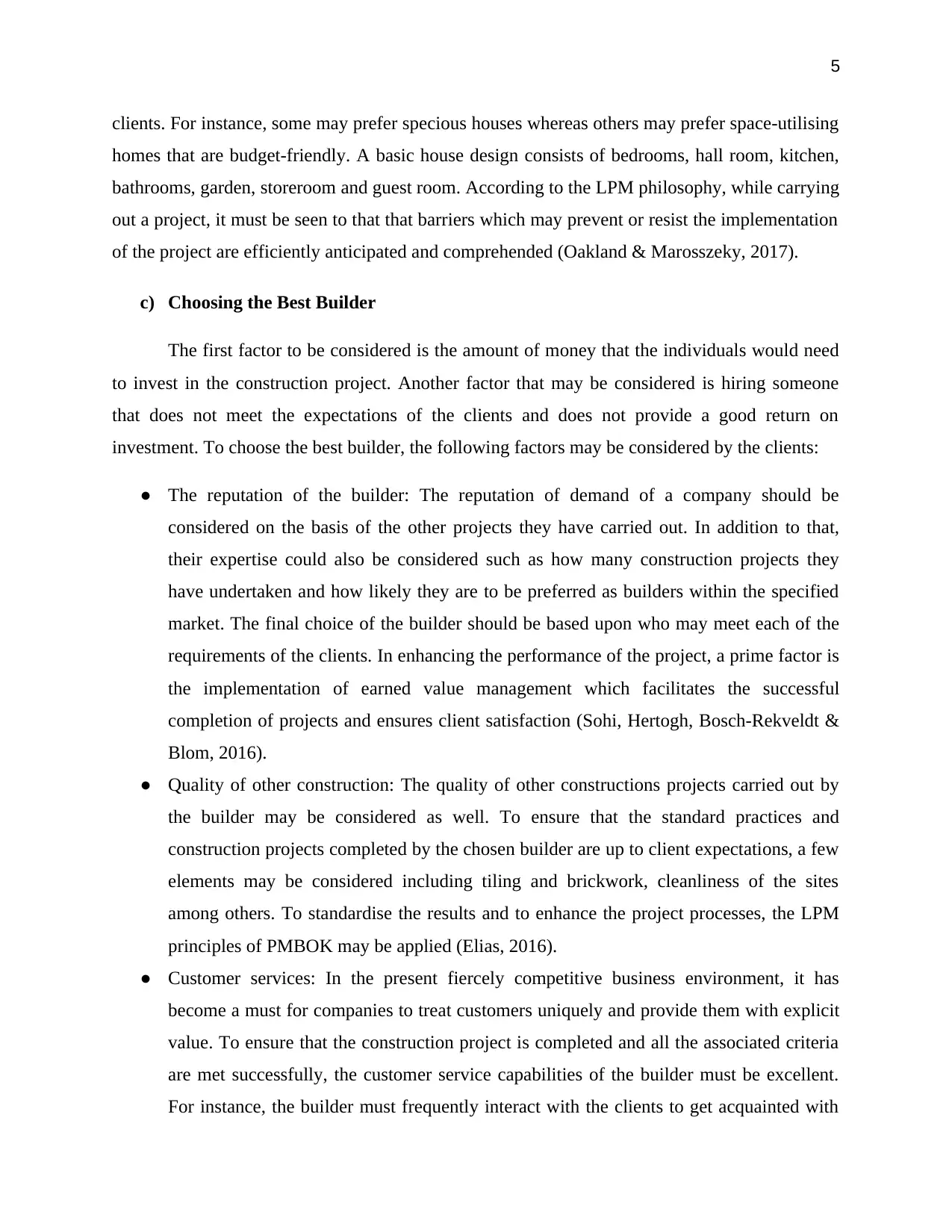
5
clients. For instance, some may prefer specious houses whereas others may prefer space-utilising
homes that are budget-friendly. A basic house design consists of bedrooms, hall room, kitchen,
bathrooms, garden, storeroom and guest room. According to the LPM philosophy, while carrying
out a project, it must be seen to that that barriers which may prevent or resist the implementation
of the project are efficiently anticipated and comprehended (Oakland & Marosszeky, 2017).
c) Choosing the Best Builder
The first factor to be considered is the amount of money that the individuals would need
to invest in the construction project. Another factor that may be considered is hiring someone
that does not meet the expectations of the clients and does not provide a good return on
investment. To choose the best builder, the following factors may be considered by the clients:
● The reputation of the builder: The reputation of demand of a company should be
considered on the basis of the other projects they have carried out. In addition to that,
their expertise could also be considered such as how many construction projects they
have undertaken and how likely they are to be preferred as builders within the specified
market. The final choice of the builder should be based upon who may meet each of the
requirements of the clients. In enhancing the performance of the project, a prime factor is
the implementation of earned value management which facilitates the successful
completion of projects and ensures client satisfaction (Sohi, Hertogh, Bosch-Rekveldt &
Blom, 2016).
● Quality of other construction: The quality of other constructions projects carried out by
the builder may be considered as well. To ensure that the standard practices and
construction projects completed by the chosen builder are up to client expectations, a few
elements may be considered including tiling and brickwork, cleanliness of the sites
among others. To standardise the results and to enhance the project processes, the LPM
principles of PMBOK may be applied (Elias, 2016).
● Customer services: In the present fiercely competitive business environment, it has
become a must for companies to treat customers uniquely and provide them with explicit
value. To ensure that the construction project is completed and all the associated criteria
are met successfully, the customer service capabilities of the builder must be excellent.
For instance, the builder must frequently interact with the clients to get acquainted with
clients. For instance, some may prefer specious houses whereas others may prefer space-utilising
homes that are budget-friendly. A basic house design consists of bedrooms, hall room, kitchen,
bathrooms, garden, storeroom and guest room. According to the LPM philosophy, while carrying
out a project, it must be seen to that that barriers which may prevent or resist the implementation
of the project are efficiently anticipated and comprehended (Oakland & Marosszeky, 2017).
c) Choosing the Best Builder
The first factor to be considered is the amount of money that the individuals would need
to invest in the construction project. Another factor that may be considered is hiring someone
that does not meet the expectations of the clients and does not provide a good return on
investment. To choose the best builder, the following factors may be considered by the clients:
● The reputation of the builder: The reputation of demand of a company should be
considered on the basis of the other projects they have carried out. In addition to that,
their expertise could also be considered such as how many construction projects they
have undertaken and how likely they are to be preferred as builders within the specified
market. The final choice of the builder should be based upon who may meet each of the
requirements of the clients. In enhancing the performance of the project, a prime factor is
the implementation of earned value management which facilitates the successful
completion of projects and ensures client satisfaction (Sohi, Hertogh, Bosch-Rekveldt &
Blom, 2016).
● Quality of other construction: The quality of other constructions projects carried out by
the builder may be considered as well. To ensure that the standard practices and
construction projects completed by the chosen builder are up to client expectations, a few
elements may be considered including tiling and brickwork, cleanliness of the sites
among others. To standardise the results and to enhance the project processes, the LPM
principles of PMBOK may be applied (Elias, 2016).
● Customer services: In the present fiercely competitive business environment, it has
become a must for companies to treat customers uniquely and provide them with explicit
value. To ensure that the construction project is completed and all the associated criteria
are met successfully, the customer service capabilities of the builder must be excellent.
For instance, the builder must frequently interact with the clients to get acquainted with
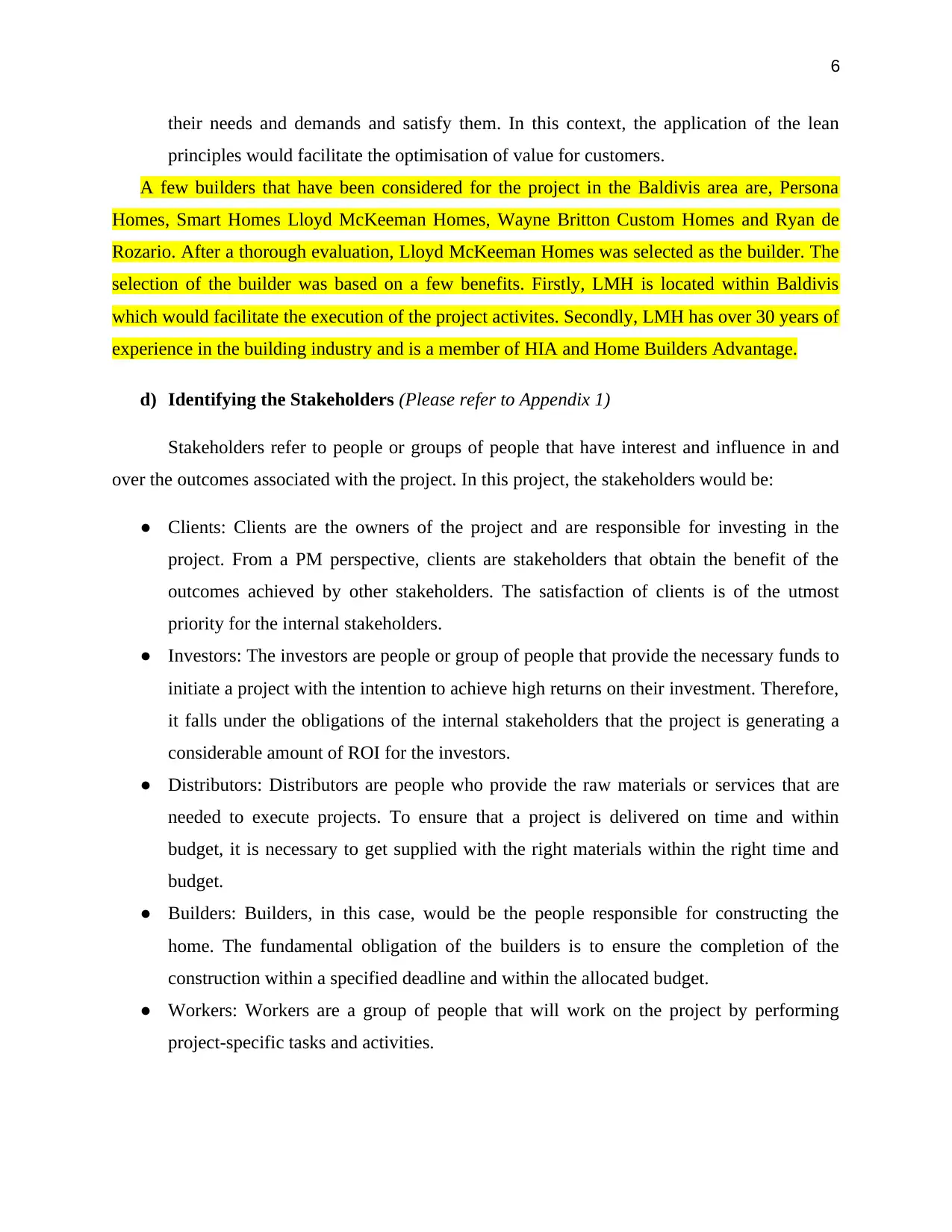
6
their needs and demands and satisfy them. In this context, the application of the lean
principles would facilitate the optimisation of value for customers.
A few builders that have been considered for the project in the Baldivis area are, Persona
Homes, Smart Homes Lloyd McKeeman Homes, Wayne Britton Custom Homes and Ryan de
Rozario. After a thorough evaluation, Lloyd McKeeman Homes was selected as the builder. The
selection of the builder was based on a few benefits. Firstly, LMH is located within Baldivis
which would facilitate the execution of the project activites. Secondly, LMH has over 30 years of
experience in the building industry and is a member of HIA and Home Builders Advantage.
d) Identifying the Stakeholders (Please refer to Appendix 1)
Stakeholders refer to people or groups of people that have interest and influence in and
over the outcomes associated with the project. In this project, the stakeholders would be:
● Clients: Clients are the owners of the project and are responsible for investing in the
project. From a PM perspective, clients are stakeholders that obtain the benefit of the
outcomes achieved by other stakeholders. The satisfaction of clients is of the utmost
priority for the internal stakeholders.
● Investors: The investors are people or group of people that provide the necessary funds to
initiate a project with the intention to achieve high returns on their investment. Therefore,
it falls under the obligations of the internal stakeholders that the project is generating a
considerable amount of ROI for the investors.
● Distributors: Distributors are people who provide the raw materials or services that are
needed to execute projects. To ensure that a project is delivered on time and within
budget, it is necessary to get supplied with the right materials within the right time and
budget.
● Builders: Builders, in this case, would be the people responsible for constructing the
home. The fundamental obligation of the builders is to ensure the completion of the
construction within a specified deadline and within the allocated budget.
● Workers: Workers are a group of people that will work on the project by performing
project-specific tasks and activities.
their needs and demands and satisfy them. In this context, the application of the lean
principles would facilitate the optimisation of value for customers.
A few builders that have been considered for the project in the Baldivis area are, Persona
Homes, Smart Homes Lloyd McKeeman Homes, Wayne Britton Custom Homes and Ryan de
Rozario. After a thorough evaluation, Lloyd McKeeman Homes was selected as the builder. The
selection of the builder was based on a few benefits. Firstly, LMH is located within Baldivis
which would facilitate the execution of the project activites. Secondly, LMH has over 30 years of
experience in the building industry and is a member of HIA and Home Builders Advantage.
d) Identifying the Stakeholders (Please refer to Appendix 1)
Stakeholders refer to people or groups of people that have interest and influence in and
over the outcomes associated with the project. In this project, the stakeholders would be:
● Clients: Clients are the owners of the project and are responsible for investing in the
project. From a PM perspective, clients are stakeholders that obtain the benefit of the
outcomes achieved by other stakeholders. The satisfaction of clients is of the utmost
priority for the internal stakeholders.
● Investors: The investors are people or group of people that provide the necessary funds to
initiate a project with the intention to achieve high returns on their investment. Therefore,
it falls under the obligations of the internal stakeholders that the project is generating a
considerable amount of ROI for the investors.
● Distributors: Distributors are people who provide the raw materials or services that are
needed to execute projects. To ensure that a project is delivered on time and within
budget, it is necessary to get supplied with the right materials within the right time and
budget.
● Builders: Builders, in this case, would be the people responsible for constructing the
home. The fundamental obligation of the builders is to ensure the completion of the
construction within a specified deadline and within the allocated budget.
● Workers: Workers are a group of people that will work on the project by performing
project-specific tasks and activities.
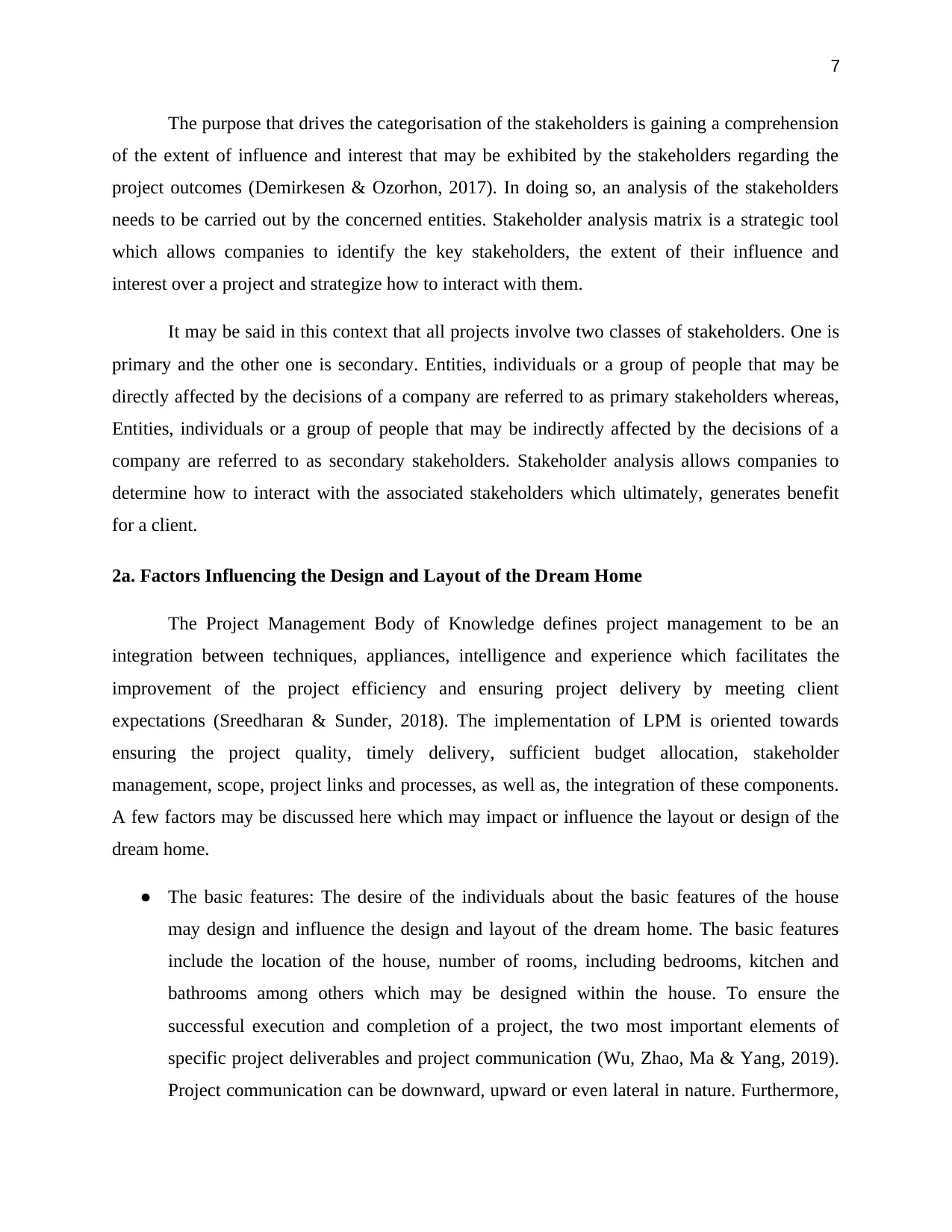
7
The purpose that drives the categorisation of the stakeholders is gaining a comprehension
of the extent of influence and interest that may be exhibited by the stakeholders regarding the
project outcomes (Demirkesen & Ozorhon, 2017). In doing so, an analysis of the stakeholders
needs to be carried out by the concerned entities. Stakeholder analysis matrix is a strategic tool
which allows companies to identify the key stakeholders, the extent of their influence and
interest over a project and strategize how to interact with them.
It may be said in this context that all projects involve two classes of stakeholders. One is
primary and the other one is secondary. Entities, individuals or a group of people that may be
directly affected by the decisions of a company are referred to as primary stakeholders whereas,
Entities, individuals or a group of people that may be indirectly affected by the decisions of a
company are referred to as secondary stakeholders. Stakeholder analysis allows companies to
determine how to interact with the associated stakeholders which ultimately, generates benefit
for a client.
2a. Factors Influencing the Design and Layout of the Dream Home
The Project Management Body of Knowledge defines project management to be an
integration between techniques, appliances, intelligence and experience which facilitates the
improvement of the project efficiency and ensuring project delivery by meeting client
expectations (Sreedharan & Sunder, 2018). The implementation of LPM is oriented towards
ensuring the project quality, timely delivery, sufficient budget allocation, stakeholder
management, scope, project links and processes, as well as, the integration of these components.
A few factors may be discussed here which may impact or influence the layout or design of the
dream home.
● The basic features: The desire of the individuals about the basic features of the house
may design and influence the design and layout of the dream home. The basic features
include the location of the house, number of rooms, including bedrooms, kitchen and
bathrooms among others which may be designed within the house. To ensure the
successful execution and completion of a project, the two most important elements of
specific project deliverables and project communication (Wu, Zhao, Ma & Yang, 2019).
Project communication can be downward, upward or even lateral in nature. Furthermore,
The purpose that drives the categorisation of the stakeholders is gaining a comprehension
of the extent of influence and interest that may be exhibited by the stakeholders regarding the
project outcomes (Demirkesen & Ozorhon, 2017). In doing so, an analysis of the stakeholders
needs to be carried out by the concerned entities. Stakeholder analysis matrix is a strategic tool
which allows companies to identify the key stakeholders, the extent of their influence and
interest over a project and strategize how to interact with them.
It may be said in this context that all projects involve two classes of stakeholders. One is
primary and the other one is secondary. Entities, individuals or a group of people that may be
directly affected by the decisions of a company are referred to as primary stakeholders whereas,
Entities, individuals or a group of people that may be indirectly affected by the decisions of a
company are referred to as secondary stakeholders. Stakeholder analysis allows companies to
determine how to interact with the associated stakeholders which ultimately, generates benefit
for a client.
2a. Factors Influencing the Design and Layout of the Dream Home
The Project Management Body of Knowledge defines project management to be an
integration between techniques, appliances, intelligence and experience which facilitates the
improvement of the project efficiency and ensuring project delivery by meeting client
expectations (Sreedharan & Sunder, 2018). The implementation of LPM is oriented towards
ensuring the project quality, timely delivery, sufficient budget allocation, stakeholder
management, scope, project links and processes, as well as, the integration of these components.
A few factors may be discussed here which may impact or influence the layout or design of the
dream home.
● The basic features: The desire of the individuals about the basic features of the house
may design and influence the design and layout of the dream home. The basic features
include the location of the house, number of rooms, including bedrooms, kitchen and
bathrooms among others which may be designed within the house. To ensure the
successful execution and completion of a project, the two most important elements of
specific project deliverables and project communication (Wu, Zhao, Ma & Yang, 2019).
Project communication can be downward, upward or even lateral in nature. Furthermore,
Paraphrase This Document
Need a fresh take? Get an instant paraphrase of this document with our AI Paraphraser
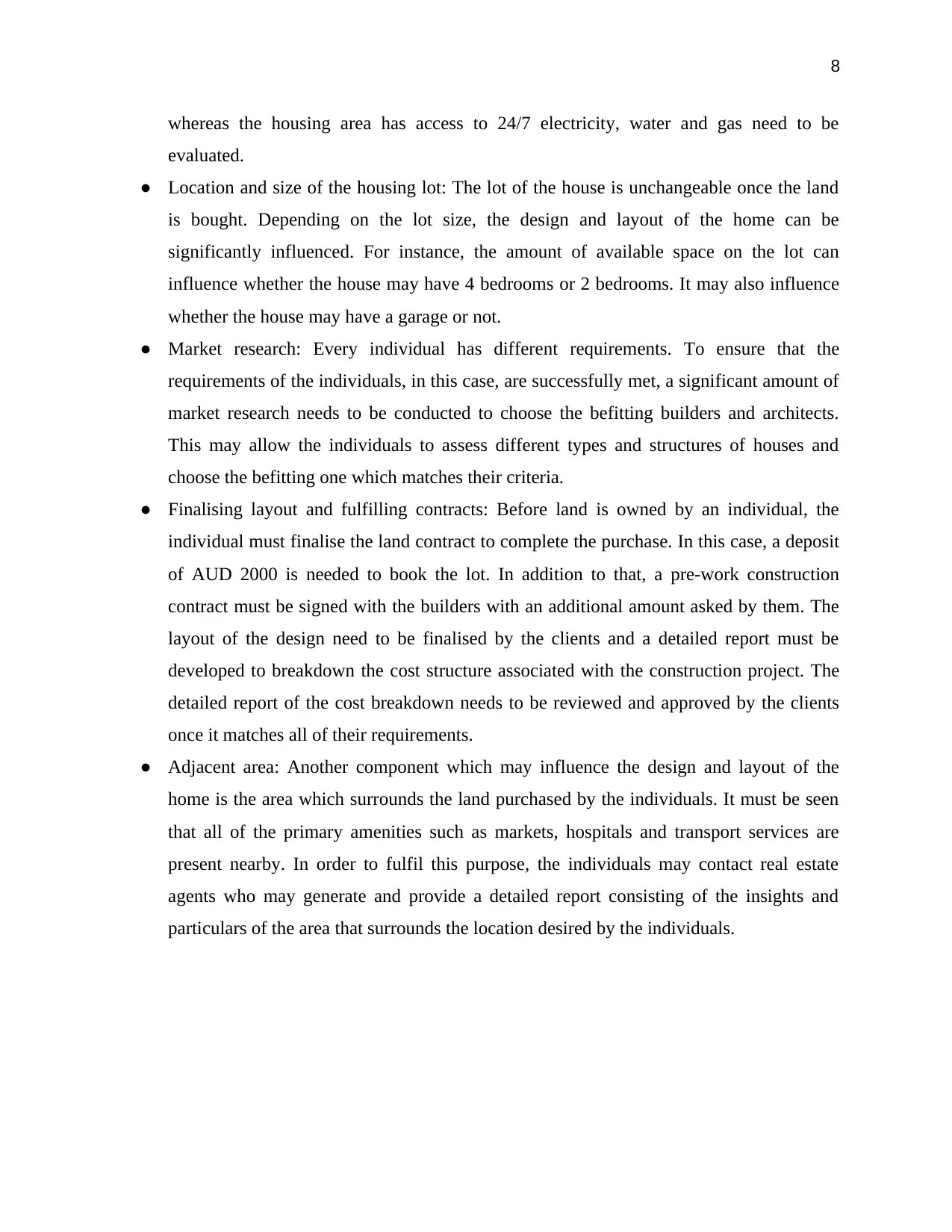
8
whereas the housing area has access to 24/7 electricity, water and gas need to be
evaluated.
● Location and size of the housing lot: The lot of the house is unchangeable once the land
is bought. Depending on the lot size, the design and layout of the home can be
significantly influenced. For instance, the amount of available space on the lot can
influence whether the house may have 4 bedrooms or 2 bedrooms. It may also influence
whether the house may have a garage or not.
● Market research: Every individual has different requirements. To ensure that the
requirements of the individuals, in this case, are successfully met, a significant amount of
market research needs to be conducted to choose the befitting builders and architects.
This may allow the individuals to assess different types and structures of houses and
choose the befitting one which matches their criteria.
● Finalising layout and fulfilling contracts: Before land is owned by an individual, the
individual must finalise the land contract to complete the purchase. In this case, a deposit
of AUD 2000 is needed to book the lot. In addition to that, a pre-work construction
contract must be signed with the builders with an additional amount asked by them. The
layout of the design need to be finalised by the clients and a detailed report must be
developed to breakdown the cost structure associated with the construction project. The
detailed report of the cost breakdown needs to be reviewed and approved by the clients
once it matches all of their requirements.
● Adjacent area: Another component which may influence the design and layout of the
home is the area which surrounds the land purchased by the individuals. It must be seen
that all of the primary amenities such as markets, hospitals and transport services are
present nearby. In order to fulfil this purpose, the individuals may contact real estate
agents who may generate and provide a detailed report consisting of the insights and
particulars of the area that surrounds the location desired by the individuals.
whereas the housing area has access to 24/7 electricity, water and gas need to be
evaluated.
● Location and size of the housing lot: The lot of the house is unchangeable once the land
is bought. Depending on the lot size, the design and layout of the home can be
significantly influenced. For instance, the amount of available space on the lot can
influence whether the house may have 4 bedrooms or 2 bedrooms. It may also influence
whether the house may have a garage or not.
● Market research: Every individual has different requirements. To ensure that the
requirements of the individuals, in this case, are successfully met, a significant amount of
market research needs to be conducted to choose the befitting builders and architects.
This may allow the individuals to assess different types and structures of houses and
choose the befitting one which matches their criteria.
● Finalising layout and fulfilling contracts: Before land is owned by an individual, the
individual must finalise the land contract to complete the purchase. In this case, a deposit
of AUD 2000 is needed to book the lot. In addition to that, a pre-work construction
contract must be signed with the builders with an additional amount asked by them. The
layout of the design need to be finalised by the clients and a detailed report must be
developed to breakdown the cost structure associated with the construction project. The
detailed report of the cost breakdown needs to be reviewed and approved by the clients
once it matches all of their requirements.
● Adjacent area: Another component which may influence the design and layout of the
home is the area which surrounds the land purchased by the individuals. It must be seen
that all of the primary amenities such as markets, hospitals and transport services are
present nearby. In order to fulfil this purpose, the individuals may contact real estate
agents who may generate and provide a detailed report consisting of the insights and
particulars of the area that surrounds the location desired by the individuals.
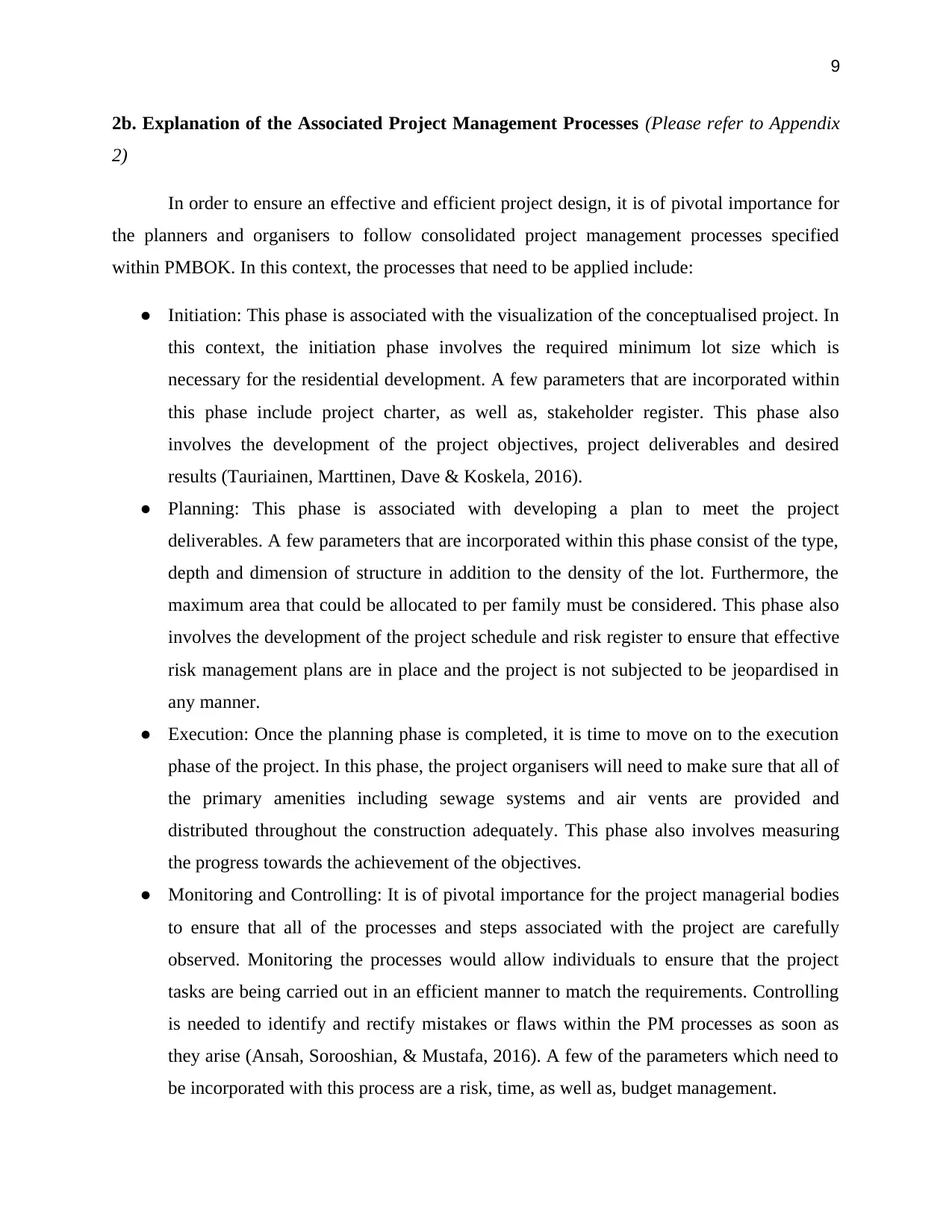
9
2b. Explanation of the Associated Project Management Processes (Please refer to Appendix
2)
In order to ensure an effective and efficient project design, it is of pivotal importance for
the planners and organisers to follow consolidated project management processes specified
within PMBOK. In this context, the processes that need to be applied include:
● Initiation: This phase is associated with the visualization of the conceptualised project. In
this context, the initiation phase involves the required minimum lot size which is
necessary for the residential development. A few parameters that are incorporated within
this phase include project charter, as well as, stakeholder register. This phase also
involves the development of the project objectives, project deliverables and desired
results (Tauriainen, Marttinen, Dave & Koskela, 2016).
● Planning: This phase is associated with developing a plan to meet the project
deliverables. A few parameters that are incorporated within this phase consist of the type,
depth and dimension of structure in addition to the density of the lot. Furthermore, the
maximum area that could be allocated to per family must be considered. This phase also
involves the development of the project schedule and risk register to ensure that effective
risk management plans are in place and the project is not subjected to be jeopardised in
any manner.
● Execution: Once the planning phase is completed, it is time to move on to the execution
phase of the project. In this phase, the project organisers will need to make sure that all of
the primary amenities including sewage systems and air vents are provided and
distributed throughout the construction adequately. This phase also involves measuring
the progress towards the achievement of the objectives.
● Monitoring and Controlling: It is of pivotal importance for the project managerial bodies
to ensure that all of the processes and steps associated with the project are carefully
observed. Monitoring the processes would allow individuals to ensure that the project
tasks are being carried out in an efficient manner to match the requirements. Controlling
is needed to identify and rectify mistakes or flaws within the PM processes as soon as
they arise (Ansah, Sorooshian, & Mustafa, 2016). A few of the parameters which need to
be incorporated with this process are a risk, time, as well as, budget management.
2b. Explanation of the Associated Project Management Processes (Please refer to Appendix
2)
In order to ensure an effective and efficient project design, it is of pivotal importance for
the planners and organisers to follow consolidated project management processes specified
within PMBOK. In this context, the processes that need to be applied include:
● Initiation: This phase is associated with the visualization of the conceptualised project. In
this context, the initiation phase involves the required minimum lot size which is
necessary for the residential development. A few parameters that are incorporated within
this phase include project charter, as well as, stakeholder register. This phase also
involves the development of the project objectives, project deliverables and desired
results (Tauriainen, Marttinen, Dave & Koskela, 2016).
● Planning: This phase is associated with developing a plan to meet the project
deliverables. A few parameters that are incorporated within this phase consist of the type,
depth and dimension of structure in addition to the density of the lot. Furthermore, the
maximum area that could be allocated to per family must be considered. This phase also
involves the development of the project schedule and risk register to ensure that effective
risk management plans are in place and the project is not subjected to be jeopardised in
any manner.
● Execution: Once the planning phase is completed, it is time to move on to the execution
phase of the project. In this phase, the project organisers will need to make sure that all of
the primary amenities including sewage systems and air vents are provided and
distributed throughout the construction adequately. This phase also involves measuring
the progress towards the achievement of the objectives.
● Monitoring and Controlling: It is of pivotal importance for the project managerial bodies
to ensure that all of the processes and steps associated with the project are carefully
observed. Monitoring the processes would allow individuals to ensure that the project
tasks are being carried out in an efficient manner to match the requirements. Controlling
is needed to identify and rectify mistakes or flaws within the PM processes as soon as
they arise (Ansah, Sorooshian, & Mustafa, 2016). A few of the parameters which need to
be incorporated with this process are a risk, time, as well as, budget management.
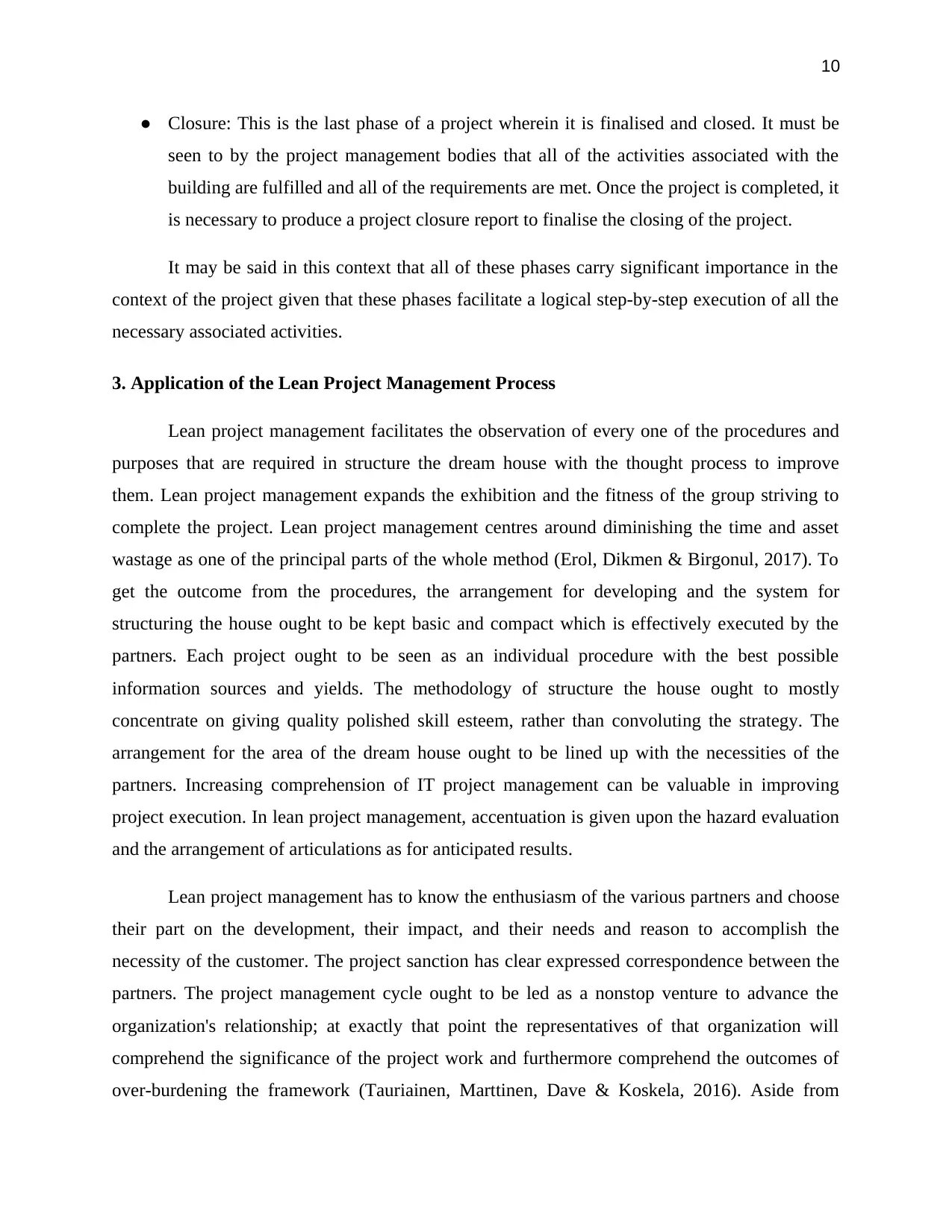
10
● Closure: This is the last phase of a project wherein it is finalised and closed. It must be
seen to by the project management bodies that all of the activities associated with the
building are fulfilled and all of the requirements are met. Once the project is completed, it
is necessary to produce a project closure report to finalise the closing of the project.
It may be said in this context that all of these phases carry significant importance in the
context of the project given that these phases facilitate a logical step-by-step execution of all the
necessary associated activities.
3. Application of the Lean Project Management Process
Lean project management facilitates the observation of every one of the procedures and
purposes that are required in structure the dream house with the thought process to improve
them. Lean project management expands the exhibition and the fitness of the group striving to
complete the project. Lean project management centres around diminishing the time and asset
wastage as one of the principal parts of the whole method (Erol, Dikmen & Birgonul, 2017). To
get the outcome from the procedures, the arrangement for developing and the system for
structuring the house ought to be kept basic and compact which is effectively executed by the
partners. Each project ought to be seen as an individual procedure with the best possible
information sources and yields. The methodology of structure the house ought to mostly
concentrate on giving quality polished skill esteem, rather than convoluting the strategy. The
arrangement for the area of the dream house ought to be lined up with the necessities of the
partners. Increasing comprehension of IT project management can be valuable in improving
project execution. In lean project management, accentuation is given upon the hazard evaluation
and the arrangement of articulations as for anticipated results.
Lean project management has to know the enthusiasm of the various partners and choose
their part on the development, their impact, and their needs and reason to accomplish the
necessity of the customer. The project sanction has clear expressed correspondence between the
partners. The project management cycle ought to be led as a nonstop venture to advance the
organization's relationship; at exactly that point the representatives of that organization will
comprehend the significance of the project work and furthermore comprehend the outcomes of
over-burdening the framework (Tauriainen, Marttinen, Dave & Koskela, 2016). Aside from
● Closure: This is the last phase of a project wherein it is finalised and closed. It must be
seen to by the project management bodies that all of the activities associated with the
building are fulfilled and all of the requirements are met. Once the project is completed, it
is necessary to produce a project closure report to finalise the closing of the project.
It may be said in this context that all of these phases carry significant importance in the
context of the project given that these phases facilitate a logical step-by-step execution of all the
necessary associated activities.
3. Application of the Lean Project Management Process
Lean project management facilitates the observation of every one of the procedures and
purposes that are required in structure the dream house with the thought process to improve
them. Lean project management expands the exhibition and the fitness of the group striving to
complete the project. Lean project management centres around diminishing the time and asset
wastage as one of the principal parts of the whole method (Erol, Dikmen & Birgonul, 2017). To
get the outcome from the procedures, the arrangement for developing and the system for
structuring the house ought to be kept basic and compact which is effectively executed by the
partners. Each project ought to be seen as an individual procedure with the best possible
information sources and yields. The methodology of structure the house ought to mostly
concentrate on giving quality polished skill esteem, rather than convoluting the strategy. The
arrangement for the area of the dream house ought to be lined up with the necessities of the
partners. Increasing comprehension of IT project management can be valuable in improving
project execution. In lean project management, accentuation is given upon the hazard evaluation
and the arrangement of articulations as for anticipated results.
Lean project management has to know the enthusiasm of the various partners and choose
their part on the development, their impact, and their needs and reason to accomplish the
necessity of the customer. The project sanction has clear expressed correspondence between the
partners. The project management cycle ought to be led as a nonstop venture to advance the
organization's relationship; at exactly that point the representatives of that organization will
comprehend the significance of the project work and furthermore comprehend the outcomes of
over-burdening the framework (Tauriainen, Marttinen, Dave & Koskela, 2016). Aside from
Secure Best Marks with AI Grader
Need help grading? Try our AI Grader for instant feedback on your assignments.
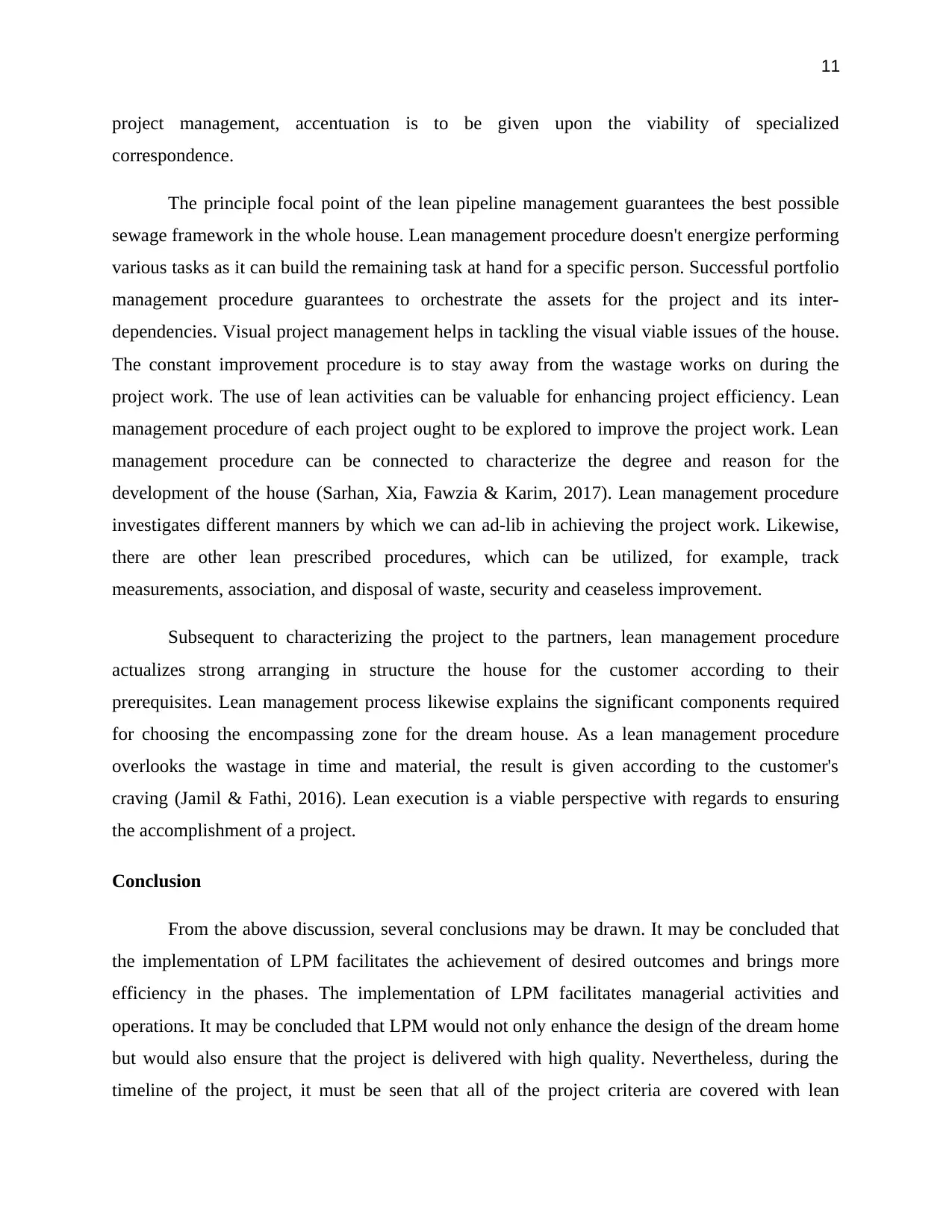
11
project management, accentuation is to be given upon the viability of specialized
correspondence.
The principle focal point of the lean pipeline management guarantees the best possible
sewage framework in the whole house. Lean management procedure doesn't energize performing
various tasks as it can build the remaining task at hand for a specific person. Successful portfolio
management procedure guarantees to orchestrate the assets for the project and its inter-
dependencies. Visual project management helps in tackling the visual viable issues of the house.
The constant improvement procedure is to stay away from the wastage works on during the
project work. The use of lean activities can be valuable for enhancing project efficiency. Lean
management procedure of each project ought to be explored to improve the project work. Lean
management procedure can be connected to characterize the degree and reason for the
development of the house (Sarhan, Xia, Fawzia & Karim, 2017). Lean management procedure
investigates different manners by which we can ad-lib in achieving the project work. Likewise,
there are other lean prescribed procedures, which can be utilized, for example, track
measurements, association, and disposal of waste, security and ceaseless improvement.
Subsequent to characterizing the project to the partners, lean management procedure
actualizes strong arranging in structure the house for the customer according to their
prerequisites. Lean management process likewise explains the significant components required
for choosing the encompassing zone for the dream house. As a lean management procedure
overlooks the wastage in time and material, the result is given according to the customer's
craving (Jamil & Fathi, 2016). Lean execution is a viable perspective with regards to ensuring
the accomplishment of a project.
Conclusion
From the above discussion, several conclusions may be drawn. It may be concluded that
the implementation of LPM facilitates the achievement of desired outcomes and brings more
efficiency in the phases. The implementation of LPM facilitates managerial activities and
operations. It may be concluded that LPM would not only enhance the design of the dream home
but would also ensure that the project is delivered with high quality. Nevertheless, during the
timeline of the project, it must be seen that all of the project criteria are covered with lean
project management, accentuation is to be given upon the viability of specialized
correspondence.
The principle focal point of the lean pipeline management guarantees the best possible
sewage framework in the whole house. Lean management procedure doesn't energize performing
various tasks as it can build the remaining task at hand for a specific person. Successful portfolio
management procedure guarantees to orchestrate the assets for the project and its inter-
dependencies. Visual project management helps in tackling the visual viable issues of the house.
The constant improvement procedure is to stay away from the wastage works on during the
project work. The use of lean activities can be valuable for enhancing project efficiency. Lean
management procedure of each project ought to be explored to improve the project work. Lean
management procedure can be connected to characterize the degree and reason for the
development of the house (Sarhan, Xia, Fawzia & Karim, 2017). Lean management procedure
investigates different manners by which we can ad-lib in achieving the project work. Likewise,
there are other lean prescribed procedures, which can be utilized, for example, track
measurements, association, and disposal of waste, security and ceaseless improvement.
Subsequent to characterizing the project to the partners, lean management procedure
actualizes strong arranging in structure the house for the customer according to their
prerequisites. Lean management process likewise explains the significant components required
for choosing the encompassing zone for the dream house. As a lean management procedure
overlooks the wastage in time and material, the result is given according to the customer's
craving (Jamil & Fathi, 2016). Lean execution is a viable perspective with regards to ensuring
the accomplishment of a project.
Conclusion
From the above discussion, several conclusions may be drawn. It may be concluded that
the implementation of LPM facilitates the achievement of desired outcomes and brings more
efficiency in the phases. The implementation of LPM facilitates managerial activities and
operations. It may be concluded that LPM would not only enhance the design of the dream home
but would also ensure that the project is delivered with high quality. Nevertheless, during the
timeline of the project, it must be seen that all of the project criteria are covered with lean
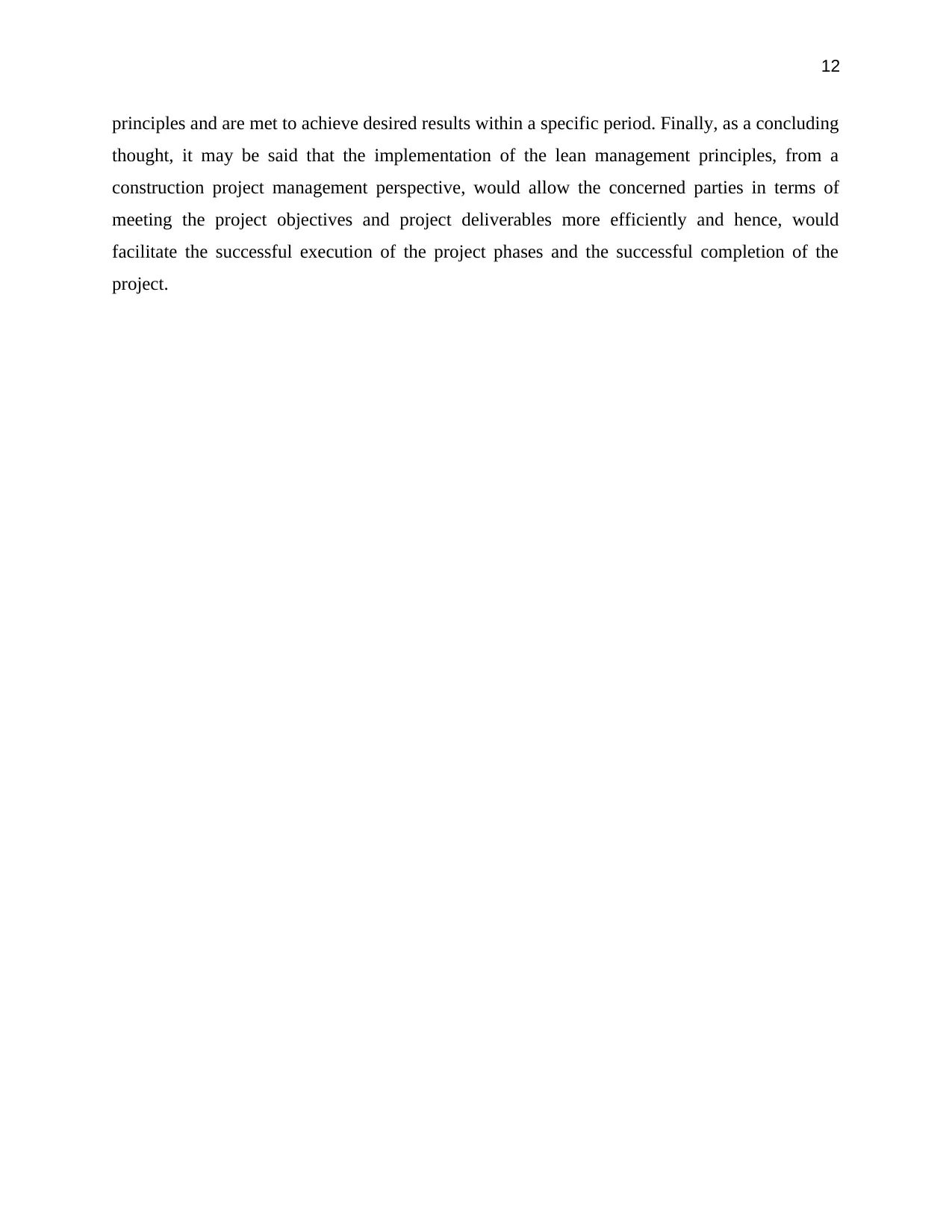
12
principles and are met to achieve desired results within a specific period. Finally, as a concluding
thought, it may be said that the implementation of the lean management principles, from a
construction project management perspective, would allow the concerned parties in terms of
meeting the project objectives and project deliverables more efficiently and hence, would
facilitate the successful execution of the project phases and the successful completion of the
project.
principles and are met to achieve desired results within a specific period. Finally, as a concluding
thought, it may be said that the implementation of the lean management principles, from a
construction project management perspective, would allow the concerned parties in terms of
meeting the project objectives and project deliverables more efficiently and hence, would
facilitate the successful execution of the project phases and the successful completion of the
project.
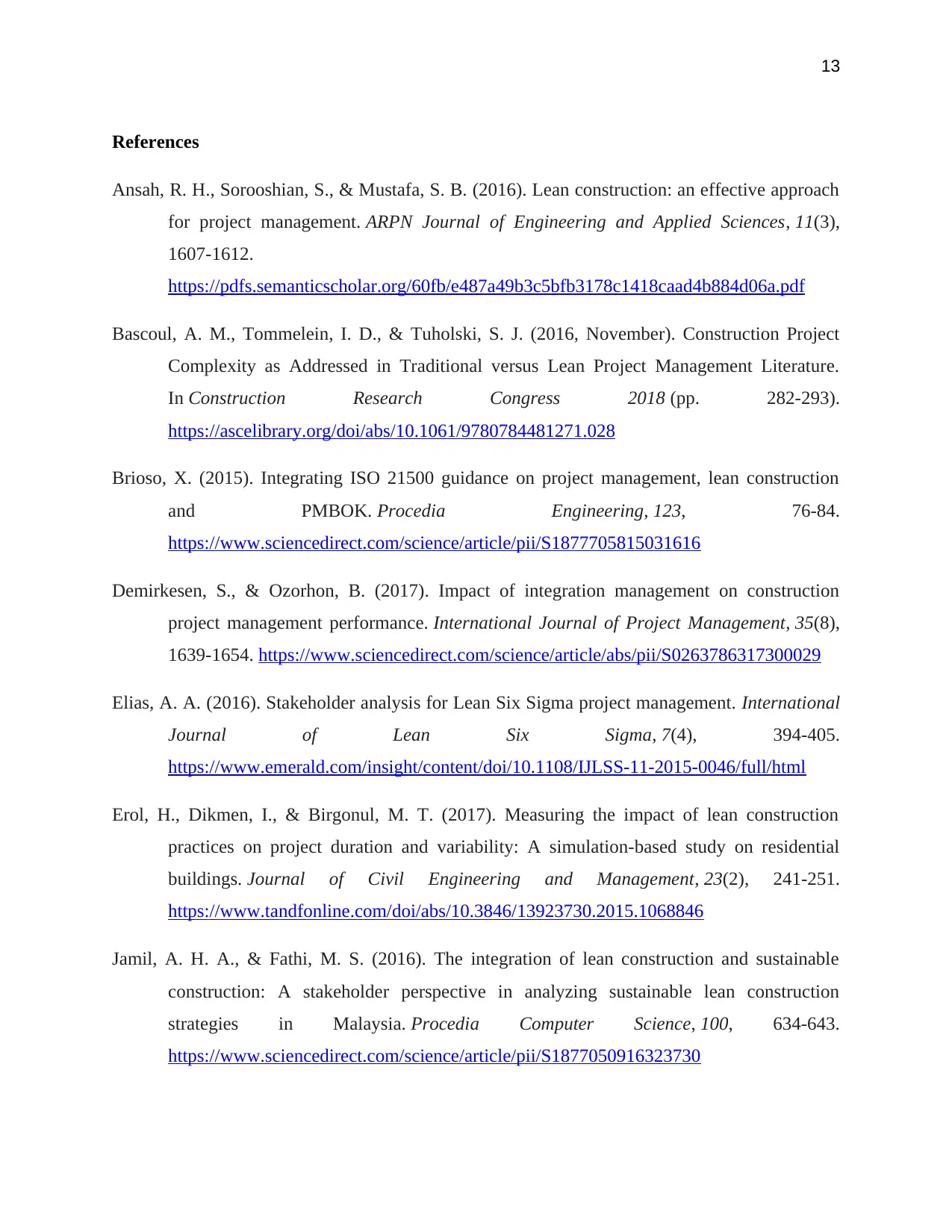
13
References
Ansah, R. H., Sorooshian, S., & Mustafa, S. B. (2016). Lean construction: an effective approach
for project management. ARPN Journal of Engineering and Applied Sciences, 11(3),
1607-1612.
https://pdfs.semanticscholar.org/60fb/e487a49b3c5bfb3178c1418caad4b884d06a.pdf
Bascoul, A. M., Tommelein, I. D., & Tuholski, S. J. (2016, November). Construction Project
Complexity as Addressed in Traditional versus Lean Project Management Literature.
In Construction Research Congress 2018 (pp. 282-293).
https://ascelibrary.org/doi/abs/10.1061/9780784481271.028
Brioso, X. (2015). Integrating ISO 21500 guidance on project management, lean construction
and PMBOK. Procedia Engineering, 123, 76-84.
https://www.sciencedirect.com/science/article/pii/S1877705815031616
Demirkesen, S., & Ozorhon, B. (2017). Impact of integration management on construction
project management performance. International Journal of Project Management, 35(8),
1639-1654. https://www.sciencedirect.com/science/article/abs/pii/S0263786317300029
Elias, A. A. (2016). Stakeholder analysis for Lean Six Sigma project management. International
Journal of Lean Six Sigma, 7(4), 394-405.
https://www.emerald.com/insight/content/doi/10.1108/IJLSS-11-2015-0046/full/html
Erol, H., Dikmen, I., & Birgonul, M. T. (2017). Measuring the impact of lean construction
practices on project duration and variability: A simulation-based study on residential
buildings. Journal of Civil Engineering and Management, 23(2), 241-251.
https://www.tandfonline.com/doi/abs/10.3846/13923730.2015.1068846
Jamil, A. H. A., & Fathi, M. S. (2016). The integration of lean construction and sustainable
construction: A stakeholder perspective in analyzing sustainable lean construction
strategies in Malaysia. Procedia Computer Science, 100, 634-643.
https://www.sciencedirect.com/science/article/pii/S1877050916323730
References
Ansah, R. H., Sorooshian, S., & Mustafa, S. B. (2016). Lean construction: an effective approach
for project management. ARPN Journal of Engineering and Applied Sciences, 11(3),
1607-1612.
https://pdfs.semanticscholar.org/60fb/e487a49b3c5bfb3178c1418caad4b884d06a.pdf
Bascoul, A. M., Tommelein, I. D., & Tuholski, S. J. (2016, November). Construction Project
Complexity as Addressed in Traditional versus Lean Project Management Literature.
In Construction Research Congress 2018 (pp. 282-293).
https://ascelibrary.org/doi/abs/10.1061/9780784481271.028
Brioso, X. (2015). Integrating ISO 21500 guidance on project management, lean construction
and PMBOK. Procedia Engineering, 123, 76-84.
https://www.sciencedirect.com/science/article/pii/S1877705815031616
Demirkesen, S., & Ozorhon, B. (2017). Impact of integration management on construction
project management performance. International Journal of Project Management, 35(8),
1639-1654. https://www.sciencedirect.com/science/article/abs/pii/S0263786317300029
Elias, A. A. (2016). Stakeholder analysis for Lean Six Sigma project management. International
Journal of Lean Six Sigma, 7(4), 394-405.
https://www.emerald.com/insight/content/doi/10.1108/IJLSS-11-2015-0046/full/html
Erol, H., Dikmen, I., & Birgonul, M. T. (2017). Measuring the impact of lean construction
practices on project duration and variability: A simulation-based study on residential
buildings. Journal of Civil Engineering and Management, 23(2), 241-251.
https://www.tandfonline.com/doi/abs/10.3846/13923730.2015.1068846
Jamil, A. H. A., & Fathi, M. S. (2016). The integration of lean construction and sustainable
construction: A stakeholder perspective in analyzing sustainable lean construction
strategies in Malaysia. Procedia Computer Science, 100, 634-643.
https://www.sciencedirect.com/science/article/pii/S1877050916323730
Paraphrase This Document
Need a fresh take? Get an instant paraphrase of this document with our AI Paraphraser
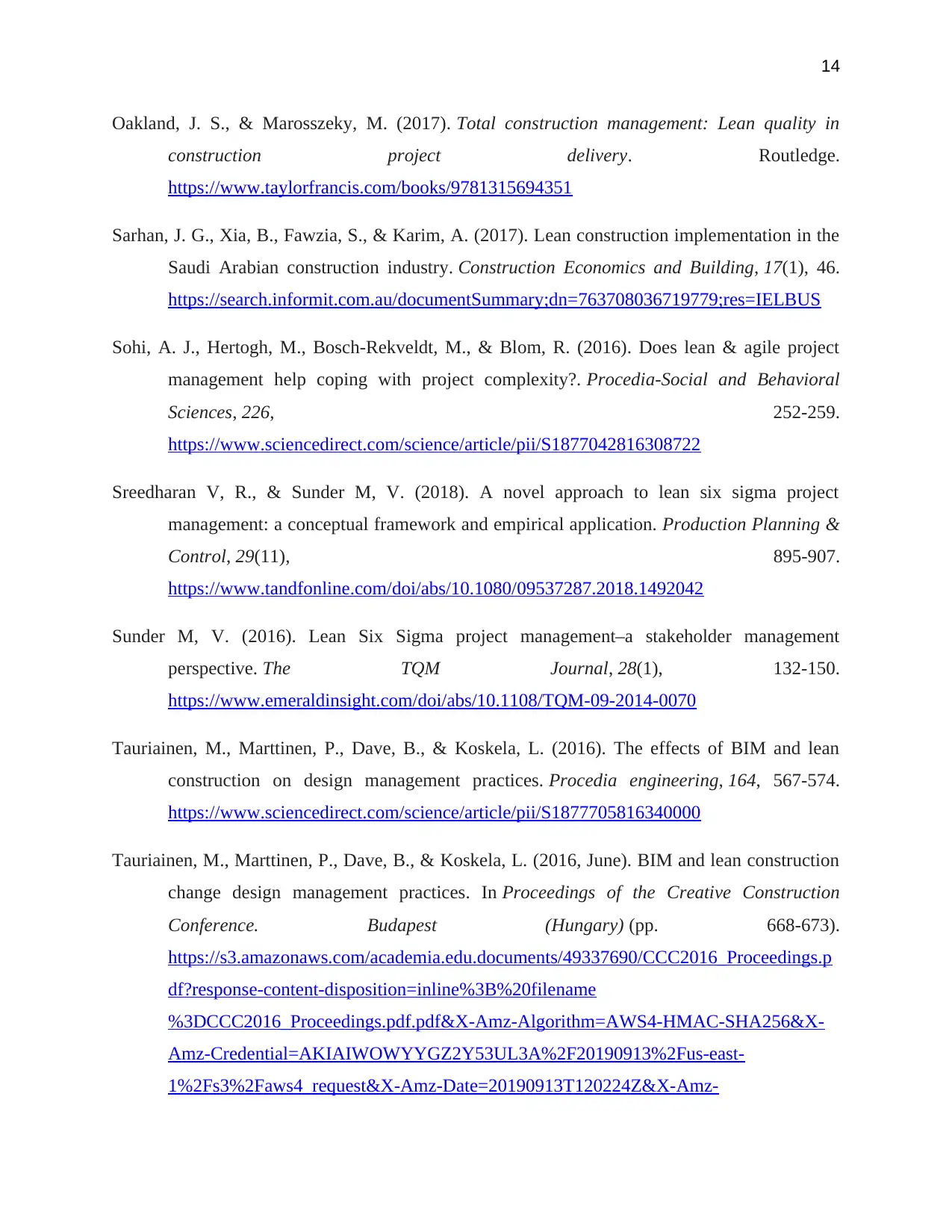
14
Oakland, J. S., & Marosszeky, M. (2017). Total construction management: Lean quality in
construction project delivery. Routledge.
https://www.taylorfrancis.com/books/9781315694351
Sarhan, J. G., Xia, B., Fawzia, S., & Karim, A. (2017). Lean construction implementation in the
Saudi Arabian construction industry. Construction Economics and Building, 17(1), 46.
https://search.informit.com.au/documentSummary;dn=763708036719779;res=IELBUS
Sohi, A. J., Hertogh, M., Bosch-Rekveldt, M., & Blom, R. (2016). Does lean & agile project
management help coping with project complexity?. Procedia-Social and Behavioral
Sciences, 226, 252-259.
https://www.sciencedirect.com/science/article/pii/S1877042816308722
Sreedharan V, R., & Sunder M, V. (2018). A novel approach to lean six sigma project
management: a conceptual framework and empirical application. Production Planning &
Control, 29(11), 895-907.
https://www.tandfonline.com/doi/abs/10.1080/09537287.2018.1492042
Sunder M, V. (2016). Lean Six Sigma project management–a stakeholder management
perspective. The TQM Journal, 28(1), 132-150.
https://www.emeraldinsight.com/doi/abs/10.1108/TQM-09-2014-0070
Tauriainen, M., Marttinen, P., Dave, B., & Koskela, L. (2016). The effects of BIM and lean
construction on design management practices. Procedia engineering, 164, 567-574.
https://www.sciencedirect.com/science/article/pii/S1877705816340000
Tauriainen, M., Marttinen, P., Dave, B., & Koskela, L. (2016, June). BIM and lean construction
change design management practices. In Proceedings of the Creative Construction
Conference. Budapest (Hungary) (pp. 668-673).
https://s3.amazonaws.com/academia.edu.documents/49337690/CCC2016_Proceedings.p
df?response-content-disposition=inline%3B%20filename
%3DCCC2016_Proceedings.pdf.pdf&X-Amz-Algorithm=AWS4-HMAC-SHA256&X-
Amz-Credential=AKIAIWOWYYGZ2Y53UL3A%2F20190913%2Fus-east-
1%2Fs3%2Faws4_request&X-Amz-Date=20190913T120224Z&X-Amz-
Oakland, J. S., & Marosszeky, M. (2017). Total construction management: Lean quality in
construction project delivery. Routledge.
https://www.taylorfrancis.com/books/9781315694351
Sarhan, J. G., Xia, B., Fawzia, S., & Karim, A. (2017). Lean construction implementation in the
Saudi Arabian construction industry. Construction Economics and Building, 17(1), 46.
https://search.informit.com.au/documentSummary;dn=763708036719779;res=IELBUS
Sohi, A. J., Hertogh, M., Bosch-Rekveldt, M., & Blom, R. (2016). Does lean & agile project
management help coping with project complexity?. Procedia-Social and Behavioral
Sciences, 226, 252-259.
https://www.sciencedirect.com/science/article/pii/S1877042816308722
Sreedharan V, R., & Sunder M, V. (2018). A novel approach to lean six sigma project
management: a conceptual framework and empirical application. Production Planning &
Control, 29(11), 895-907.
https://www.tandfonline.com/doi/abs/10.1080/09537287.2018.1492042
Sunder M, V. (2016). Lean Six Sigma project management–a stakeholder management
perspective. The TQM Journal, 28(1), 132-150.
https://www.emeraldinsight.com/doi/abs/10.1108/TQM-09-2014-0070
Tauriainen, M., Marttinen, P., Dave, B., & Koskela, L. (2016). The effects of BIM and lean
construction on design management practices. Procedia engineering, 164, 567-574.
https://www.sciencedirect.com/science/article/pii/S1877705816340000
Tauriainen, M., Marttinen, P., Dave, B., & Koskela, L. (2016, June). BIM and lean construction
change design management practices. In Proceedings of the Creative Construction
Conference. Budapest (Hungary) (pp. 668-673).
https://s3.amazonaws.com/academia.edu.documents/49337690/CCC2016_Proceedings.p
df?response-content-disposition=inline%3B%20filename
%3DCCC2016_Proceedings.pdf.pdf&X-Amz-Algorithm=AWS4-HMAC-SHA256&X-
Amz-Credential=AKIAIWOWYYGZ2Y53UL3A%2F20190913%2Fus-east-
1%2Fs3%2Faws4_request&X-Amz-Date=20190913T120224Z&X-Amz-
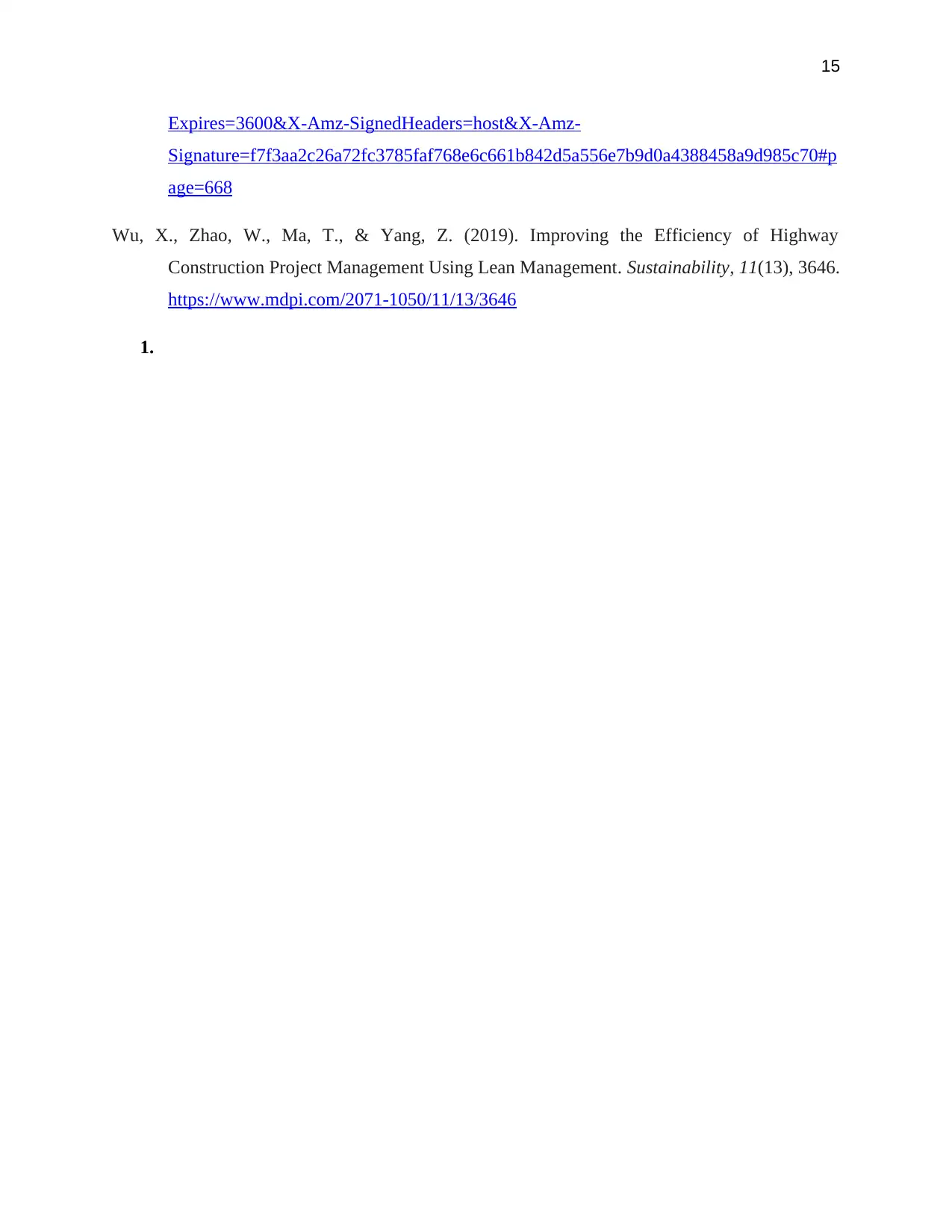
15
Expires=3600&X-Amz-SignedHeaders=host&X-Amz-
Signature=f7f3aa2c26a72fc3785faf768e6c661b842d5a556e7b9d0a4388458a9d985c70#p
age=668
Wu, X., Zhao, W., Ma, T., & Yang, Z. (2019). Improving the Efficiency of Highway
Construction Project Management Using Lean Management. Sustainability, 11(13), 3646.
https://www.mdpi.com/2071-1050/11/13/3646
1.
Expires=3600&X-Amz-SignedHeaders=host&X-Amz-
Signature=f7f3aa2c26a72fc3785faf768e6c661b842d5a556e7b9d0a4388458a9d985c70#p
age=668
Wu, X., Zhao, W., Ma, T., & Yang, Z. (2019). Improving the Efficiency of Highway
Construction Project Management Using Lean Management. Sustainability, 11(13), 3646.
https://www.mdpi.com/2071-1050/11/13/3646
1.
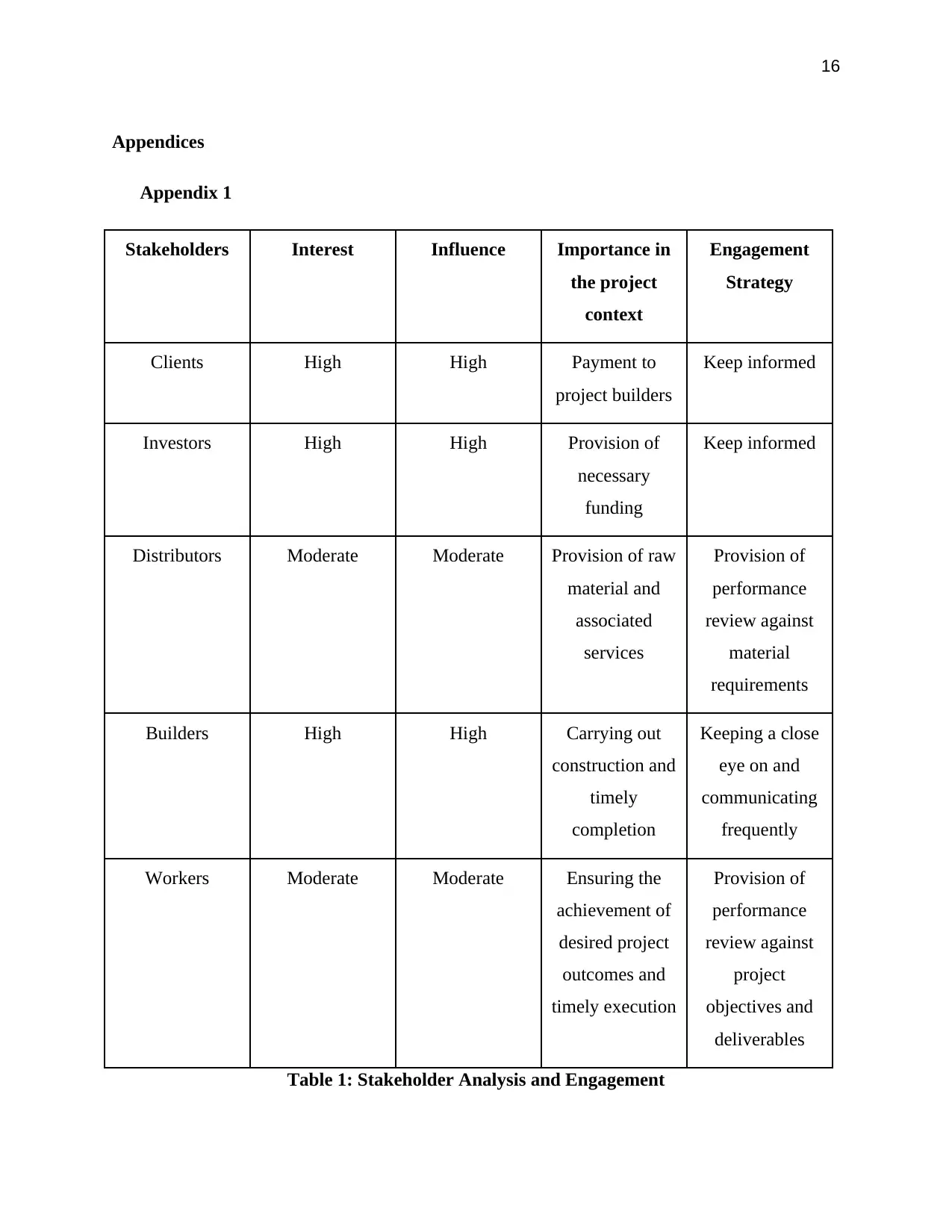
16
Appendices
Appendix 1
Stakeholders Interest Influence Importance in
the project
context
Engagement
Strategy
Clients High High Payment to
project builders
Keep informed
Investors High High Provision of
necessary
funding
Keep informed
Distributors Moderate Moderate Provision of raw
material and
associated
services
Provision of
performance
review against
material
requirements
Builders High High Carrying out
construction and
timely
completion
Keeping a close
eye on and
communicating
frequently
Workers Moderate Moderate Ensuring the
achievement of
desired project
outcomes and
timely execution
Provision of
performance
review against
project
objectives and
deliverables
Table 1: Stakeholder Analysis and Engagement
Appendices
Appendix 1
Stakeholders Interest Influence Importance in
the project
context
Engagement
Strategy
Clients High High Payment to
project builders
Keep informed
Investors High High Provision of
necessary
funding
Keep informed
Distributors Moderate Moderate Provision of raw
material and
associated
services
Provision of
performance
review against
material
requirements
Builders High High Carrying out
construction and
timely
completion
Keeping a close
eye on and
communicating
frequently
Workers Moderate Moderate Ensuring the
achievement of
desired project
outcomes and
timely execution
Provision of
performance
review against
project
objectives and
deliverables
Table 1: Stakeholder Analysis and Engagement
Secure Best Marks with AI Grader
Need help grading? Try our AI Grader for instant feedback on your assignments.
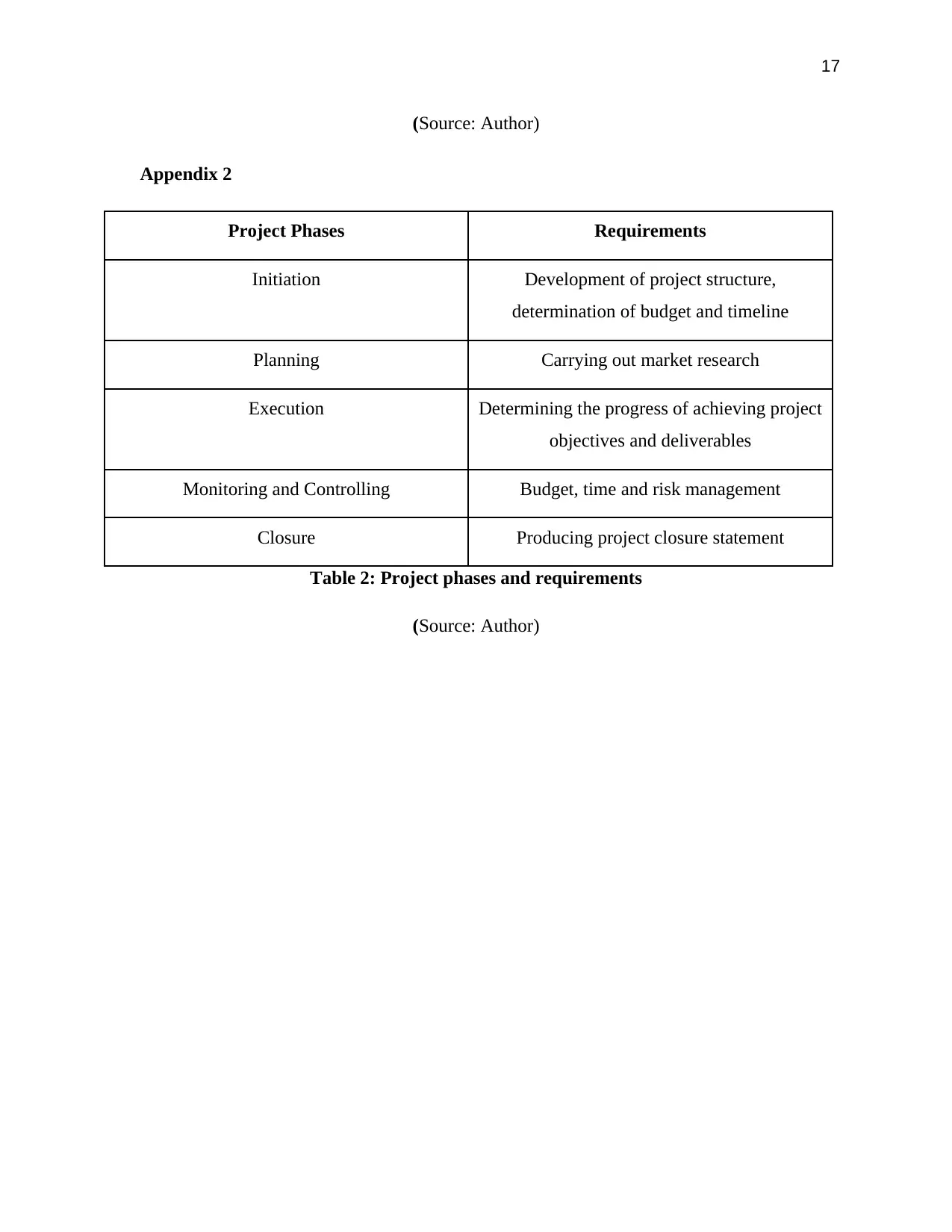
17
(Source: Author)
Appendix 2
Project Phases Requirements
Initiation Development of project structure,
determination of budget and timeline
Planning Carrying out market research
Execution Determining the progress of achieving project
objectives and deliverables
Monitoring and Controlling Budget, time and risk management
Closure Producing project closure statement
Table 2: Project phases and requirements
(Source: Author)
(Source: Author)
Appendix 2
Project Phases Requirements
Initiation Development of project structure,
determination of budget and timeline
Planning Carrying out market research
Execution Determining the progress of achieving project
objectives and deliverables
Monitoring and Controlling Budget, time and risk management
Closure Producing project closure statement
Table 2: Project phases and requirements
(Source: Author)
1 out of 17
Your All-in-One AI-Powered Toolkit for Academic Success.
+13062052269
info@desklib.com
Available 24*7 on WhatsApp / Email
![[object Object]](/_next/static/media/star-bottom.7253800d.svg)
Unlock your academic potential
© 2024 | Zucol Services PVT LTD | All rights reserved.





